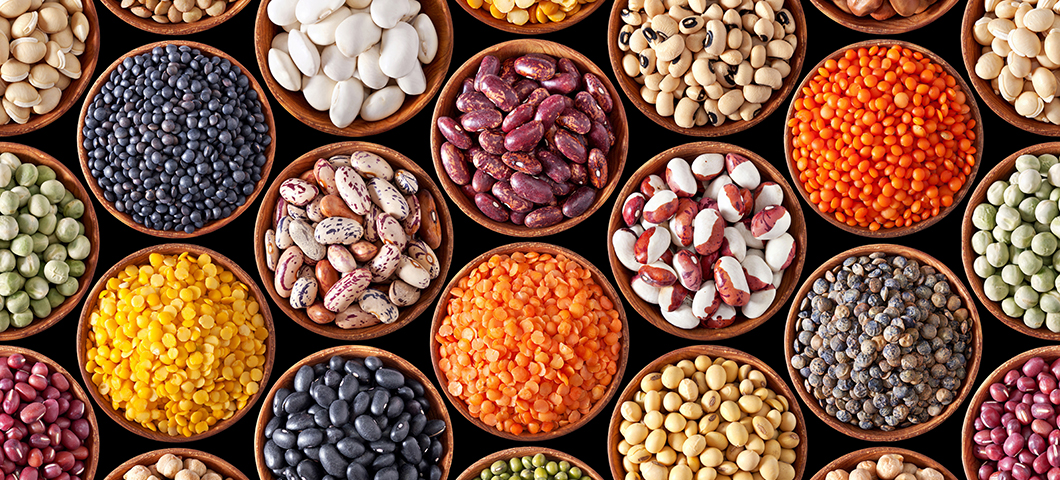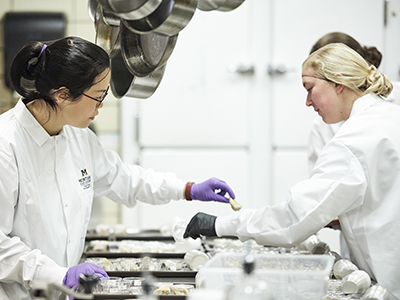Pulses
Pulses are the dry, edible seeds of legumes such as beans, chickpeas, and lentils. They are highly nutritious, containing around 20-26% protein, 17-25% fiber, the essential amino acid lysine, phytochemicals, and essential minerals. Additionally, pulse proteins are gluten-free, non-GMO, and are not among the top eight allergens (Food and Agriculture Organization, 2017). Montana now ranks as the nation's No. 1 producer of field peas, chickpeas, and lentils (National Agricultural Statistics Service, 2020). The daily consumption of pulses has been linked to the reduced risk, improved management, and even the reversal of chronic diseases including heart disease, cancer, and diabetes. Montana has become a top producer of pulses, which are not only healthy for humans but for the environment as well, as they revitalize soils through their symbiotic relationship with nitrogen-fixing soil bacteria. The American Institute for Cancer Research recommends consuming three daily servings of pulses. Serving size examples include "one quarter cup of hummus or bean dip; a half cup of cooked beans, split peas, lentils, tofu, or tempeh; or a full cup of fresh peas or sprouted lentils." (NutritionFacts.org)
Projects
Culinary, nutritional, and value-added potentials of Montana pulses - A geographical survey among four states
The lack of knowledge in the nutritional and application properties of Montana pulses makes it challenging to enter the global premium pulse market and to establish North American value-added markets. We are working with the MSU Pulse Crop Breeding Program to compare the culinary, nutritional, and processing qualities of pulses from Montana and other pulse-producing states. Three chickpea varieties, including Sierra, Orion, and Marvel, and two lentil varieties, including Richlea and Pardina, will be collected from eleven USDA Agricultural Experiment Stations across four states. These stations represent the different geographical growing regions, including five regions in Montana, and two regions each in Idaho, Washington, and North Dakota. The same five pulse varieties from the eleven regions will be compared for their soaking and cooking performances, as well as macronutrient levels including protein, carbohydrates, fat, fiber, and minerals. Selected samples from Montana and from other states will further be compared for their consumer acceptance and sensory profiles, as well as their extrusion performances. This project will provide scientific data to evidence Montana pulses’ competitiveness in the global trade markets. The findings from this project will also provide geographical implications to advance the growing, post-harvest handling, and product innovation of Montana pulse crops.
Establishing the industry and market for Montana’s high-value fractionated pulse ingredients via food product innovation
High-value fractionated pulse ingredients such as lentil protein concentrate and pea starch have gained global attention due to their excellent nutritional profile, low allergenicity, and less environmental impact. These fractionated ingredients are highly versatile in a wide range of food applications from bakery, beverage, to meat analogs. In 2019, the plant-based meat market size in the US exceeded $800 million, with an estimated compound annual growth rate above 25% between 2020 and 2026. Texturized plant proteins are gaining selling points for their meat-mimicking qualities while being lower in ecological footprint. As the nation's top pulse producer, Montana exports predominantly pulse seeds at lower values (around $0.30/lb. for lentils), instead of fractionated pulse ingredients (around $20/lb. for protein concentrates) or other value-added products.
To maximize the market opportunity of Montana pulse crops, our researchers partnered with Montana pulse stakeholders to investigate the potential of high-value fractionated pulse ingredients in developing texturized pulse protein (TPP) and other food products. The objectives include (1) Source high-value fractionated pulse ingredients from Montana food industries; (2) Develop TPP from Montana fractionated pulse proteins with extrusion technology; (3) Develop value-added consumer food products using fractionated pulse ingredients and TPP. This project will establish Montana’s first TPP extrusion technology and create product recipes using Montana fractionated pulse ingredients and TPP, which will advance Montana’s pulse technology and encourage more Montana value-added pulse products to enter the market.


